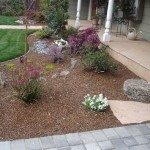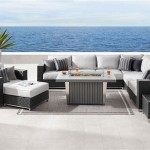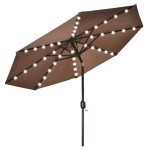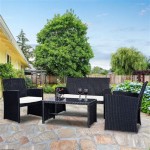```html
Patio Garden Design Ideas: Creating an Outdoor Oasis
A patio garden offers an opportunity to transform a small outdoor space into a personal sanctuary. Whether the patio is a sprawling deck or a compact balcony, thoughtful design can maximize its potential, creating an aesthetically pleasing and functional extension of the home. Considerations such as plant selection, furniture arrangement, and hardscaping elements contribute to a harmonious and inviting outdoor living area.
Optimizing Space and Layout
Effective patio garden design begins with a careful assessment of the available space. Analyzing the dimensions, sun exposure, and existing features is crucial for planning a layout that is both visually appealing and practical. In smaller patios, vertical gardening techniques such as wall planters or hanging baskets can maximize planting space without encroaching on valuable ground area. Modular furniture, which can be easily rearranged or folded away when not in use, provides flexibility for different activities and social gatherings.
The placement of furniture should prioritize both comfort and functionality. Creating distinct zones for dining, lounging, and gardening can enhance the versatility of the patio. A small dining table and chairs provide a dedicated space for outdoor meals, while comfortable seating with outdoor cushions and throws encourages relaxation. Strategic placement of plants can create visual barriers, define spaces, and provide privacy from neighboring properties.
Consider the flow of movement through the patio. Pathways should be clear and unobstructed, allowing for easy access to all areas. Stepping stones or gravel paths can add visual interest and guide visitors through the garden. Incorporating elements such as water features or sculptures can create focal points and draw the eye to specific areas of the patio.
For awkward or unusually shaped patios, custom solutions may be required. Built-in benches or planters can maximize space utilization and create a cohesive design. Utilizing every nook and cranny with carefully chosen plants and decorative elements can transform even the most challenging patio into a charming outdoor retreat.
Plant Selection and Design Principles
The selection of plants is fundamental to the success of a patio garden. Plants not only add color, texture, and visual interest but also contribute to the overall ambiance of the space. Choosing plants that are well-suited to the local climate, soil conditions, and sun exposure is essential for their long-term health and vitality.
Consider incorporating a mix of plant types, including annuals, perennials, and shrubs, to provide a continuous display of color and interest throughout the growing season. Annuals offer a burst of vibrant color, while perennials provide a more sustainable and long-lasting foundation. Shrubs can add structure and create a backdrop for other plants. Container gardening allows for experimentation with different plant combinations and provides flexibility for changing the design as desired.
When selecting plants, consider their growth habits and mature size. Avoid choosing plants that will quickly outgrow their containers or become too large for the patio space. Dwarf varieties of trees and shrubs are often a good choice for smaller patios. Grouping plants with similar needs together simplifies watering and maintenance.
Employing design principles such as repetition, contrast, and balance can enhance the visual appeal of the patio garden. Repeating certain plant types or colors throughout the space creates a sense of unity. Contrasting textures and forms adds visual interest. Balancing tall plants with low-growing ones prevents the design from feeling lopsided. Consider the color palette and how it complements the surrounding architecture and furniture.
Incorporate herbs and vegetables into the patio garden for a functional and aesthetically pleasing addition. Growing herbs in containers near the kitchen door provides easy access for cooking. Vertical planters can be used to grow strawberries, tomatoes, and other vegetables in a limited space. The addition of edible plants adds another dimension to the patio garden and encourages a closer connection with nature.
Hardscaping and Decorative Elements
Hardscaping elements, such as paving materials, walls, and fences, play a crucial role in defining the structure and character of the patio garden. The choice of hardscaping materials should complement the style of the house and create a cohesive design. Consider using materials that are durable, weather-resistant, and easy to maintain.
Paving materials can range from traditional brick and stone to modern concrete pavers and composite decking. The choice of material will depend on the desired aesthetic and budget. Consider using permeable paving materials to allow rainwater to drain into the ground, reducing runoff and promoting a healthier garden environment.
Walls and fences provide privacy, define boundaries, and create a backdrop for plants. A low wall or fence can be used to create a sense of enclosure without completely blocking the view. Trellises and pergolas can provide support for climbing plants and create shaded areas. Consider incorporating built-in seating into the design of walls and fences to maximize space utilization.
Decorative elements, such as outdoor lighting, water features, and garden art, add personality and character to the patio garden. Outdoor lighting extends the usability of the patio into the evening hours and creates a warm and inviting ambiance. String lights, lanterns, and spotlights can be used to highlight specific features or create a soft glow.
Water features, such as fountains or small ponds, add a soothing element to the patio garden. The sound of running water can be relaxing and help to mask unwanted noise. Garden art, such as sculptures, birdbaths, and wind chimes, adds a personal touch and reflects the homeowner's individual style. Choose decorative elements that are durable, weather-resistant, and appropriate in scale for the patio space.
Adding a fire pit or outdoor fireplace can extend the use of the patio into the cooler months. Fire pits provide warmth and ambiance, creating a cozy gathering space for friends and family. Outdoor fireplaces can be used for cooking and entertaining. Consider the safety regulations and fire codes in the local area before installing a fire pit or outdoor fireplace.
The integration of architectural elements from the home, such as matching the siding, window trim, or roofing materials, can help to create a seamless transition between the interior and exterior spaces. This continuity in design strengthens the feeling that the patio is a true extension of the home, enhancing its overall aesthetic appeal and functional value.
Ultimately, successful patio garden design involves a careful consideration of space, plant selection, hardscaping, and personal style. The creation of a truly inviting and functional outdoor space requires time, planning, and a willingness to experiment with different ideas.
```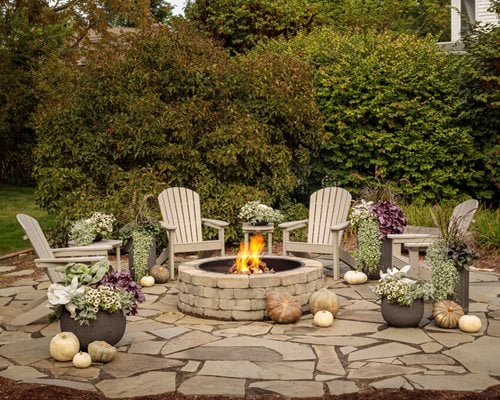
Backyard Landscaping Ideas Garden Design

25 Best Small Garden Ideas Clever For Gardens

40 Amazing Small Garden Ideas And Designs Renoguide N Renovation Inspiration

N Academy Of Garden Design Blog Inspiration Outdoor Space And Patio Ideas

Backyard Landscaping Ideas Garden Design

The Best Small Patio Ideas To Eoy This Summer

Patio Design Ideas Garden Gate
Garden Design Ideas For Small Gardens Gardening Learning With Experts

Patio Design Ideas Backyard Garden Landscaping Designs Around

Small Garden Design Ideas To Transform Outside Spaces
Related Posts


